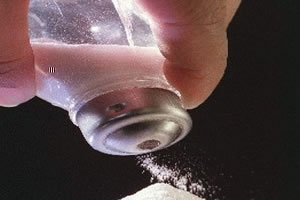ion-formula is the name given to the formula of any chemical substance formed from a ionic bond between the atoms. As it involves an ionic bond, the formula ion has the presence of a metal atom and a nonmetal atom or the presence of a metal atom and a hydrogen atom.
The general writing of an ion-formula is:
XY
X represents the metallic element atom and Y represents the atom of any non-metal or hydrogen. The metal indication always appears first in a formula ion, as we can see in the examples bellow:
NaCl (Sodium Chloride)
KI (Potassium iodide)
CaO (calcium oxide)
Al2O3 (Chromium III oxide)
MgO (Magnesium Oxide)
MgCl2 (Magnesium chloride)
To assemble a formula ion, we must first take into account the need to lose or gain electrons to achieve the octet rule of each of the atoms involved in the ionic bond. The need for each atom varies according to its nature (metal or non-metal) and its periodic family, that is:
IA Family: All elements are metals and have an electron in the valence shell, so they need to lose an electron, becoming a cation 1+.
IIA Family: All elements are metals and have two electrons in the valence shell, so they need to lose two electrons, becoming a cation 2+.
Family IIIA: The elements have three electrons in the valence shell. If it's metal, it needs to lose three electrons, becoming a 3+ cation. In the case of boron, which is ametal, it must gain three electrons, becoming a anion 3-.
VAT Family: The elements have four electrons in the valence shell. If it's metal, it needs to lose four electrons, becoming a 4+ cation. In the case of carbon and silicon, which are non-metals, they need to gain four electrons, becoming a anion 4-.
-
VA family: The elements have five electrons in the valence shell. If it's metal, it needs to lose five electrons, becoming a 5+ cation. In the case of nitrogen, phosphorus and arsenic, which are non-metals, they must gain three electrons, becoming a anion 3-.
Do not stop now... There's more after the advertising ;)
VIA Family: The elements have six electrons in the valence shell. If it is non-metal, it needs to gain two electrons, becoming a anion 2-.
VIIA Family: The elements have seven electrons in the valence shell. If it is non-metal, they need to gain an electron, becoming a anion 1-.
Thus, if we know the family of atoms involved and the nature of each one of them, we just need to find the charges (a+ and b-) and cross-multiply so that the charge of each becomes the amount (b and a) of the other in the formula ion resulting.
Xa+ withYB- → XBYThe
See some examples:
Example 1: ion-formula originated between the element Barium (Ba) and the element sulfur (S):
Barium: IIA family, metal, 2+ charge.
Sulfur: VIA family, ametal, charge 2-.
So, we have the following ions:
Ba2+ with S2- → Ba2s2
Since the quantities are equal, we can disregard the numbers and write the formula ion just as BaS.
Example 2: ion-formula originated between the element Potassium (K) and the element Bromine (Br):
Potassium: IA family, metal, charge 1+
Bromine: family VIIA, non-metal, charge 1-
So, we have the following ions:
K1+ comBr1- → K1br1
Since the quantities are equal, we can disregard the numbers and write the formula ion just as KBr.
Example 3: ion-formula originated between the element Indium (In) and the element Oxygen (O):
Indian: family IIIA, metal, load 3+
Oxygen: VIA family, non-metal, charge 2-
So, we have the following ions:
In3+ withO2-→ In2O3
Example 4: ion-formula originated between the element Lead (Pb) and the element Nitrogen (N):
Lead: VAT family, metal, load 4+
Nitrogen: VA family, non-metal, charge 3-
So, we have the following ions:
Pb4+ withN3- → Pb3N4
By Me. Diogo Lopes Dias
Would you like to reference this text in a school or academic work? Look:
DAYS, Diogo Lopes. "What is a formula ion?"; Brazil School. Available in: https://brasilescola.uol.com.br/o-que-e/quimica/o-que-e-um-ion-formula.htm. Accessed on June 27, 2021.
Chemical formulas, flat structural formula, Couper structural formula, triple bond, gas nitrogen, electronic formula, Lewis formula, molecular formula, single bond, double bond, gas carbonic.
Chemistry

Ionic bond, arrangements between ionic compounds, ionic agglomerates, sodium chloride, table salt, ionic substance, electrostatic attraction forces, chloride anions, sodium cations, polar solvents, positive ions, cations, negative ions, anions.

